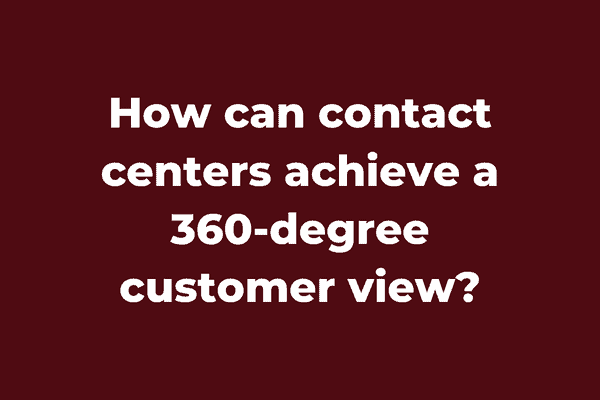To provide top-notch customer support, contact centers need to have an exhaustive and comprehensive customer perspective. Thus, the need of a 360-degree customer viewpoint.
A 360-degree customer view is an approach that allows contact centers to gain a complete understanding of the customer through collecting and analyzing data from multiple sources. The data usually includes information such as customer demographics and purchase history. By having a thorough customer view, contact centers can better understand their clientele and provide more personalized service.
Key points:
- The benefits of having a 360-degree customer view and how it improves the customer experience
- Data integration and how the ways to collect and process data effectively
- CRM systems’ role in achieving a 360-degree customer view
- The methodology to successfully implement a 360-degree customer view
Achieving the 360-Degree Customer View in Contact Centers
In present times, providing seamless customer interactions is a must. Having a 360-degree customer view is one way contact centers can achieve this. Through it, they can gather data from different sources and analyze I to better understand the customer. Such data includes customer demographics, purchase history, and interactions with the company. And with this information, contact centers can offer a more personalized service to their customers.
One of the many approaches to achieve a 360-degree customer view is using a CRM system. Customer Relationship Systems gather and store customer data, that encompasses contact information, purchase history and previous interactions with the company.
Another approach to achieve a complete customer view is through data analytics. Contact centers, through gathering data from multiple sources, can gain a better understanding of the customers. And eventually identify trends and patterns to further improve the customer experience.
Moreover, contact centers can use feedback, such as surveys and reviews, to gain insight into customers’ preferences and disinclinations about their interactions with the company, and take steps to redress the issues.
In the following chapter, we will further discuss the benefits of having a 360-degree customer view.
How does having a 360-degree view of customers improve the customer experience in contact centers?
Having a 360-degree view of customers improves the customer experience in contact centers in several ways:
- Personalization:
A 360-degree view of the customer allows contact centers to understand the customer’s preferences, needs, and history. This will enable them to provide a more personalized experience by offering relevant products or services and addressing customer concerns more effectively. - Proactive service:
With a 360-degree view of the customer, contact centers can anticipate customer needs and take proactive steps to address them. For example, suppose a customer has a history of requesting certain assistance. In that case, the contact center can anticipate those needs and readily access the relevant information when the customer calls. - Faster resolution:
By thoroughly understanding the customer’s history, contact centers can quickly identify and resolve issues. This can help to reduce handling times and improve the overall efficiency of the contact center. And thus help achieve a 360-degree customer view. - Improved customer satisfaction:
A 360-degree view of the customer allows contact centers to provide a better overall experience for the customer. This can lead to higher levels of customer satisfaction and loyalty. - Better data-driven decisions:
Having a 360-degree view of the customer allows contact centers to make better decisions about improving the customer experience. This can include identifying areas for improvement or targeting specific segments of customers for targeted campaigns.
Data Integration for a Complete Customer View
Data integration is critical to achieving a complete customer view in contact centers. It involves combining data from multiple sources to create a comprehensive and holistic view of the customer. Here are some ways that data integration can help achieve a complete customer view:
- Combining data from multiple systems: Data integration allows contact centers to combine data from different methods, such as a CRM system, website analytics, and social media, to create a complete view of the customer.
- Improving data quality: Data integration helps enhance data quality by identifying and removing duplicate or inaccurate information. This ensures that the data used to create the customer view is accurate and reliable.
- Enhancing data analysis: Data integration allows contact centers to analyze data from multiple sources, which can provide a complete understanding of the customer. This can help identify patterns and trends to improve the customer experience.
- Enabling real-time insights: Data integration allows contact centers to access and analyze data in real-time, to provide proactive and personalized service.
- Improving data security: Data integration also helps improve data security by ensuring that data is collected, stored, and analyzed securely and promptly.
- Reducing data silos: Data integration reduces silos of data and allows all teams to access the same data and have the same understanding of the customer; this helps create a consistent customer experience and drives better outcomes.
- Making better data-driven decisions: Data integration allows contact centers to make better decisions by providing.
Hard data and Soft data
Hard data refers to factual and quantifiable information easily measured and analyzed in customer data. This data is often stored in structured databases and can include customer demographics, purchase history, and contact information. Complex data identifies patterns and trends and helps make data-driven decisions.
Soft data, however, refers to qualitative information that is more subjective and harder to quantify. This type of data can include customer feedback, opinions, and emotions. Soft data can provide valuable insights into customer attitudes and perceptions in order to identify areas for improvement in the customer experience.
Achieving a 360-degree customer view requires integrating hard and soft data. Complex data provides an accurate understanding of the customer, while weak data provides a more subjective experience of the customer’s attitudes and perceptions. Together, hard and soft data can provide a complete and holistic view of the customer.
In summary, Hard data can be quantified and measured and used to identify patterns and trends. Soft data is the more subjective data used to identify customer attitudes and perceptions. Both types of data are essential to achieve a 360-degree customer view.
How can contact centers integrate customer data from various sources to achieve a complete view?
There are several ways that contact centers can integrate customer data from various sources to achieve a complete view:
- Customer Relationship Management (CRM) systems:
They can gather, store, and analyze customer data from multiple sources. This can include information such as contact information, purchase history, and interactions with the company. - Data warehousing and Business Intelligence (BI) tools:
These tools gather, store, and analyze data from multiple sources, such as social media, website analytics, and customer feedback. This can provide a complete understanding of the customer and help identify patterns and trends. - API integration:
API (Application Programming Interface) integration allows different systems to share data in real time. This can include integrating data from a CRM system with data from a website analytics platform or data from a survey tool with data from a customer feedback platform. - Cloud-based solutions:
Cloud-based solutions store and analyze data from multiple sources, having the possibility to be accessed from anywhere. Such as our OMNI+ entirely cloud-based solution. This allows contact centers to gather data from various sources and access it in real-time, which can be used to improve the customer experience. - Data Governance and Data Quality:
Having a robust data governance and data quality process in place is essential to ensure the data being integrated is accurate, consistent, and reliable; this ensures that the data being used to create the customer view is accurate and reliable. - Employee training:
Finally, it’s essential to train the contact center employees to use the various data sources, navigate the systems, and interpret the data. This will help ensure that the data is being used effectively and that the customer experience is being improved.
We talk about training and coaching contact center staff and more in our webinar episode available through here.
How can CRM systems facilitate data integration and provide a 360-degree view of customers?
Customer Relationship Management (CRM) systems can be used to facilitate data integration and provide a 360-degree view of customers in several ways:
- Centralized data storage:
CRM systems provide a centralized location to store customer data gathered from multiple sources such as website analytics, social media, and customer feedback. This allows contact centers to create a complete view of the customer by combining data from different sources. - Data visualization:
CRM systems often provide visual representations of customer data, such as charts and graphs, to identify patterns and trends. This can help contact centers understand customer behavior and preferences to improve the customer experience. - Automated data analysis:
CRM systems can use automated tools to analyze customer data, such as using machine learning algorithms to identify patterns and trends. This allows contact centers to identify and address issues impacting the customer experience quickly. - Proactive service:
CRM systems anticipate customer needs and take proactive steps to address them. For example, suppose a customer has a history of requesting certain assistance. In that case, the contact center can anticipate those needs and readily access the relevant information when the customer calls. - Accessibility:
CRM systems allow contact center employees to access customer data from anywhere, anytime. This will enable them to provide better service, as they have access to all information about the customer in one place. - Data Governance and quality:
It is primordial to ensure that the data collected is in-par with the quality processes in place. To guarantee that the integrated data is accurate and reliable.
Implementing a 360-Degree View in Practice
Implementing a 360-degree view of customers in practice can involve several steps, that include:
- Identifying the data sources:
The first step is identifying all the data sources used to create the customer view. This can include data from CRM systems, website analytics, social media, and customer feedback. - Data integration:
The next step is integrating the data from different sources. This can involve using data warehousing and business intelligence (BI) tools, API integration, or cloud-based solutions. - Data governance and quality:
It is primordial to ensure that the data collected is in-par with the quality processes in place. To guarantee that the integrated data is accurate and reliable. - Visualizing the data:
Once the data has been successfully integrated, it is fundamental to provide visual representations through charts and graphs to identify patterns and trends. This can help to better understand the customers, and provide more personalized service. - Automating data analysis:
Automating data analysis, such as using machine learning algorithms, can help contact centers quickly identify and address issues impacting the customer experience. - Segmentation:
Segmenting customers based on different criteria, such as demographics, purchase history, and interactions with the company, can help target specific segments of customers with personalized messages and offers. - Employee training:
Employees must undergo training on how to use the various data sources, navigate the systems, and interpret the data. This will help ensure effective data use to improve the customer experience. - Proactive service:
Contact centers can anticipate customer needs and take proactive steps to address them after analyzing and integrating the data; this will help gain a 360-degree view of the customer.

How can contact centers use customer journey mapping to identify gaps in their customer view?
In contact centers, customer mapping can be used to understand the customer journey and identify any pain points or issues that customers may have when interacting with the center.
The process typically involves the following steps:
- Identifying key touchpoints:
The first step is to identify all the key touchpoints that customers have with the company, such as website interactions, phone calls, and social media interactions. - Gathering customer data:
Collect data on customer interactions and feedback at each touchpoint, including data from various sources such as CRM systems, website analytics, and customer feedback. - Creating the customer journey map:
Once the data is available, it aids in visually representing the customer journey, showing the different touchpoints and the customer’s experience at each one. - Identifying gaps:
By analyzing the customer journey map, contact centers can identify gaps in the customer experience. These gaps can include where customers are dropping off, experiencing delays, or not receiving the service they expect. - Improving the customer experience:
Once the gaps in the customer view are pinned, contact centers can take steps to improve the customer experience. This can include making changes to processes, providing additional training to employees, or implementing new technologies. - Measuring and monitoring:
Finally, measuring and monitoring the customer experience over time is essential to ensure that the changes made have had the desired effect and that the customer view is complete.
How can data analytics and contact center metrics be used to track progress and measure success in achieving a 360-degree customer view?
Data analytics and contact center metrics are useful to track progress and measure success in achieving a 360-degree customer view in several ways:
- Identifying key performance indicators (KPIs):
To effectively track and measure progress over time, contact centers need to identify the most relevant KPIs to the customer experience. These include customer satisfaction, first-call resolution, and the net promoter score. - Analyzing customer data:
To improve the customer experience, contact centers analyze data compiled from different sources. Such as customer feedback, website analytics and CRM systems, thus providing insight into customer behavior and preferences. - Real-time monitoring:
This is useful for contact centers as it enables them to identify issues when they arise and take immediate measures to remedy them. - Reporting and dashboards:
To provide a clear depiction of the customer experience, contact centers visualize and report metrics through the use of dashboards. Allowing them to pinpoint improvement areas and track progress over time. - A/B testing:
A/B testing is commonly used to test multiple approaches, regarding process changes and training programs, and assess their effectiveness in improving the customer experience. This is useful to determine which modifications bear the most significant results. - Automated Data analysis:
Automating data analysis, through the use of machine learning algorithms, helps contact centers identify patterns and trends. Which further improves decision-making and enhances the overall customer experience. - Segmentation:
Segmenting customers based on criteria such as demographics and previous interactions with the company is proven beneficial in understanding other customer segments’ preferences.
Conclusion
In conclusion, achieving a 360-degree customer view is essential for contact centers to improve the customer experience. By having a complete view of customers, contact centers can anticipate customer needs and take proactive steps to address them, which leads to more satisfied customers. Additionally, by integrating customer data from various sources, contact centers can identify patterns and trends in customer behavior, which can be used to make data-driven decisions that improve the customer experience.
Contact centers can also explore technologies such as natural language processing, sentiment analysis, and predictive analytics to further improve the customer experience.
Experience the ultimate customer engagement solution with NobelBiz Omni+. Our all-in-one contact center software offers advanced features such as omnichannel support, intelligent call routing, and real-time analytics. All backed by 24/7 customer support.
Boost your team’s productivity and improve customer satisfaction and retention with NobelBiz OMNI+.

Andrei is an experienced marketing professional specializing in propelling growth for both B2B and B2C companies. Proficient in streamlining marketing operations and enhancing lead and customer experiences through SEO and marketing techniques.







